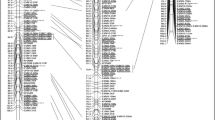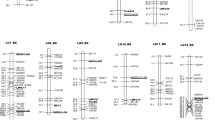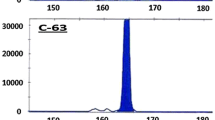Abstract
Sweetpotato genomic research is minimal compared to most other major crops despite its worldwide importance as a food crop. The development of a genetic linkage map in sweetpotato will provide valuable information about the genomic organization of this important species that can be used by breeders to accelerate the introgression of desired traits into breeding lines. We developed a mapping population consisting of 240 individuals of a cross between ‘Tanzania’, a cream-fleshed African landrace, and ‘Beauregard’, an orange-fleshed US sweetpotato cultivar. The genetic linkage map of this population was constructed using Amplified Fragment Length Polymorphism (AFLP) markers. A total of 1944 (‘Tanzania’) and 1751 (‘Beauregard’) AFLP markers, of which 1511 and 1303 were single-dose markers respectively, were scored. Framework maps consisting of 86 and 90 linkage groups for ‘Tanzania’ and ‘Beauregard’ respectively, were developed using a combination of JoinMap 3.0 and MAPMAKER/EXP 3.0. A total of 947 single-dose markers were placed in the final framework linkage map for ‘Tanzania’. The linkage map size was estimated as 5792 cM, with an average distance between markers of 4.5 cM. A total of 726 single-dose markers were placed in the final framework map for ‘Beauregard’. The linkage map length was estimated as 5276 cM, with an average distance between markers of 4.8 cM. Duplex and triple-dose markers were used to identify the corresponding homologous groups in the maps. Our research supports the hypothesis that sweetpotato is an autopolyploid. Distorted segregation in some markers of different dosages in this study suggests that some preferential pairing occurs in sweetpotato. However, strict allopolyploid inheritance in sweetpotato can be ruled out due to the observed segregation ratios of the markers, and the proportion of simplex to multiple-dose markers.










Similar content being viewed by others
References
Becker J, Vos P, Kuiper M, Salamini F, Heun M (1995) Combined mapping of AFLP and RFLP markers in barley. Mol Gen Genet 249:65–73
Broun P, Tanksley SD (1996) Characterization and genetic mapping of simple repeat sequences in tomato genome. Mol Gen Genet 250:39–49
Castiglioni P, Ajmone-Marsan P, van Wijk R, Motto M (1999) AFLP markers in a molecular linkage map of maize: codominant scoring and linkage group distribution. Theor Appl Genet 99:425–431
Cervantes-Flores JC, Davis EL, Yencho GC (2002a) Efficient evaluation of resistance to three root-knot nematode species in selected sweetpotato cultivars. HortScience 37:390–392
Cervantes-Flores JC, Davis EL, Yencho GC (2002b) Host reactions of sweetpotato genotypes to root-knot nematodes and variation in virulence of Meloidogyne incognita populations. HortScience 37:1112–1116
Chetelat RT, Meglic V, Cisneros P (2000) A genetic map of tomato based on a BC1 Lycopersicon esculentum × Solanum lycopersicoides reveals overall synteny but suppressed recombination between these homeologous genomes. Genetics 154:857–867
CIP (2005) CIP sweetpotato facts: production, utilization, consumption and feed use. International Potato Center. http://www.cipotato.org/sweetpotato/sweetpotato.htm)
Collins WW, Carey EE, Mok IG, Thompson P, Zhang DP (1999) Utilization of sweetpotato genetic resources to develop insect-resistance. In: Clement SL, Quisenberry SS (eds) Global genetic resources for insect-resistant crops. CRC Press, Boca Raton, FL, USA, pp. 193–205
Costanzo S, Simko I, Christ BJ, Haynes KG (2005) QTL analysis of late blight resistance in a diploid potato family of Solanum phureja x S. stenotomum. Theor Appl Genet 111:609–617
Cregan PB, Jarvik T, Bush AL, Shoemaker RC, Lark KG, Kahler AL, Kaya N, VanToai TT, Lohnes DG, Chung J, Specht JE (1999) An integrated genetic linkage map of the soybean genome. Crop Sci 39(5):1464–1490
da Silva JAG (1993) A methodology for genome mapping of autopolyploids and its application to sugarcane (Saccharum spp.). Ph D Dissertation, Cornell University, Ithaca, NY
da Silva J, Honeycutt RJ, Burnquist W, Al-Janabi SM, Sorrells ME, Tanksley SD, Sobral BWS (1995) Saccharum spontaneum L. ‘SES 208’ genetic linkage map combining RFLP- and PCR-based markers. Mol Breeding 1:165–179
da Silva JA, Sorrells ME (1996) Linkage análisis in polyploids using molecular markers. In: Jauhar PP (ed) Methods of genome analysis in plants, CRC Press
da Silva JAG, Sorrells MS, Burnquish WL, Tanksley SD (1993) RFLP linkage map and genome análisis of Saccharum spontaneum. Genome 36:782–791
Doyle JJ, Doyle JL (1990) Isolation of plant DNA from fresh tissue. Focus 12:13–15
Dugo ML, Satovic Z, Millán T, Cubero JI, Rubiales D, Cabrera A, Torres AM (2005) Genetic mapping of QTLs controlling horticultural traits in diploid roses Theor Appl Genet 111:511–520
FAOSTAT (2006) Food and Agriculture Organization of the United Nations, Production Statistics (http://faostat.fao.org/)
Fregene M, Angel F, Gomez R, Rodriguez F, Chavarriaga P, Roca W, Tohme J, Bonierbale M (1997) A molecular genetic map of cassava (Manihot esculenta Crantz). Theor Appl Genet 95:431–441
Gebhardt C, Ritter E, Debener T, Schachtschabel U, Walkemeier B, Urig H, Salamini F (1989) RFLP analysis and linkage mapping in Solanum tuberosum. Theor Appl Genet 78:65–75
Ghislain M, Trognitz B, Herrera MdR, Solis J, Casallo G, Vasquez C, Hurtado O, Castillo R, Portal L, Orrillo M (2001) Genetic loci associated with field resistance to late blight in offspring of Solanum phureja and S. tuberosum grown under short-day conditions. Theor Appl Genet 103:433–442
Ghislain M, Spooner DM, Rodríguez F, Villamón F, Nuñez J, Vásquez C, Waugh R, Bonierbale M (2004) Selection of highly informative and user-friendly microsatellites (SSRs) for genotyping of cultivated potato. Theor Appl Genet 108:881–890
Gill KS, Gill BS, Endo TR, Boyko EV (1996) Identification and high-density mapping of gene-rich regions in chromosome group 5 of wheat. Genetics 143:1001–1012
Grattapaglia D, Sederoff R (1994) Genetic linkage maps of Eucalyptus grandis and E. urophylla using a pseudo-testcross mapping strategy and RAPD markers. Genetics 137:1121–1137
Harushima Y, Yano M, Shomura A, Sato M, Shimano T, Kuboki Y, Yamamoto T, Lin SY, Antonio BA, Parco A, Kajiya H, Huang N, Yamamoto K, Nagamura Y, Kurata N, Khush GS, Sasaki T (1998) A high-density rice genetic linkage map with 2275 markers using a single F2 population. Genetics 148:479–494
Hermsen JG (1984) Nature, evolution and breeding of polyploids. Iowa State J Res 58:411–420
Hoarau JY, Offman B, D’Hont A, Risterucci AM, Roques D, Glaszmann JC, Grivet L (2001) Genetic dissection of a modern sugarcane cultivar (Saccharum spp.) I. Genome mapping with AFLP markers. Theor Appl Genet 103:84–97
Ihaka R, Gentleman R (1996) R: A language for data analysis and graphics. J Comput Graph Stat 5:299–314
Isidore E, Van Os H, Andrzejewski S, Bakker J, Barrena I, Bryan GJ, Caromel B, Van Eck H, Ghareeb B, de Jong W, Van Koert P, Lefebvre V, Milbourne D, Ritter E, Van der Voort JR, Rousselle-Bourgeois F, Van Vliet J, Waugh R (2003) Toward a marker-dense meiotic map of the potato genome: lessons from linkage group I. Genetics 165:2107–2116
Jones A (1965) Cytological observations and fertility measurements of sweetpotato [Ipomoea batatas (L.) Lam.] Proc Am Soc Hort Sci 86:527–537
Jones A (1967) Theoretical segregation ratios of qualitatively inherited characters for hexaploid sweetpotato (Ipomoea batatas). Bul No. 1368. USDA Tech
Jones A (1986) Sweetpotato heritability estimates and their use in breeding. HortScience 21:14–17
Kosambi DD (1944) The estimation of map distances from recombination values. Ann Eugen 12:172–175
Kriegner A (2001) Genetic linkage mapping, determination of ploidy type, and genetic variability of hexaploid sweetpotato (Ipomoea batatas (L.) Lam.). Dissertation, University of Bodenkultur, Vienna, Austria
Kriegner A, Cervantes JC, Burg K, Mwanga ROM, Zhang D (2003) A genetic linkage map of sweetpotato [Ipomoea batatas (L.) Lam.] based on AFLP markers. Mol Breeding 11:169–185
Lander ES, Green P, Abrahamson J, Barlow A, Daly MJ, Lincoln SE, Newburg L (1987) MapMaker: an interactive computer package for constructing primarily genetic linkage maps of experimental and natural populations. Genomics 1:174–181
Lefevre G (1970) Salivary chromosome band and the frequency of crossing over in Drosophila melanogaster. Genetics 67:497–513
Li JZ, Huang ZQ, Heinrichs F, Ganal MW, Röder MS (2005) Analysis of QTLs for yield, yirld components, and malting quality in a BC3–DH population of spring barley. Theor Appl Genet 110:356–363
Lindahl KF (1991) His and hers recombinational hotspots. Trends Genet 7:273–276
Liu BH (1998) Statistical genomics: linkage mapping and QTL analysis. CRC Press LLC, Boca Raton, Florida, USA
Magoon ML, Krishnar R, Bai VK (1970) Cytological evidences on the origin of sweetpotato. Theor Appl Genet 40:360–366
Meyer RC, Milbourne D, Hackett CA, Bradshaw JE, McNichol JW, Waugh R (1998) Linkage analysis in tetraploid potato and association of markers with quantitative resistance to late blight (Phytophthora infestans). Mol Gen Genet 259:150–160
Milbourne D, Meyer RC, Collins AJ, Ramsay LD, Gebhardt C, Waugh R (1998) Isolation, characterization and mapping of simple sequence repeat loci in potato. Mol Gen Genet 259:233–245
Murray MG, Thompson WF (1980) Rapid isolation of high molecular weight plant DNA. Nucleic Acid Res 8:4321–4325
Mwanga ROM, Kriegner A, Cervantes-Flores JC, Zhang DP, Moyer JW, Yencho GC (2002) Resistance to sweetpotato chlorotic stunt virus and sweetpotato feathery mottle virus is mediated by two separate recessive genes in sweetpotato. J Am Soc Hort Sci 127:798–806
Myburg AA, Remington DL, O’Malley DM, Sederoff RR, Whetten RW (2001) High-throughput AFLP analysis using infrared dye-labeled primers and an automated DNA sequencer. Biotechniques 30:348–357
Nishiyama I, Niyazaki T, Sakamoto S (1975) Evolutionary autopolyploidy in sweetpotato [Ipomoea batatas (L.) Lam] and its progenitors. Euphytica 24:197–208
Opperman R, Emmanuel E, Levy AA (2004) The effect of sequence divergence on recombination between direct repeats in Arabidopsis. Genetics 168: 2207–2215
Ozias-Akins P, Jarret RL (1994) Nuclear DNA content and ploidy levels in the genus Ipomoea. J Am Soc Hort Sci 119:110–115
Qu L, Hancock JF (1997) Randomly amplified polymorphic DNA- (RAPD-) based genetic linkage map of blueberry derived from an interspecific cross between diploid Vaccinium darrowi and tetraploids V. corymbosum. J Am Soc Hort Sci 122:69–73
Ramsey J, Schemske DW (2002) Neopolyploidy in flowering plants. Annu Rev Ecol Syst 33:589–639
Ripol MI, Churchill GA, da Silva JAG, Sorrells M (1999) Statistical aspects of genetic mapping in autopolyploids. Gene 235:31–41
Ritter E, Gebhardt C, Salamini F (1990) Estimation of recombination frequencies and construction of RFLP linkage maps in plants from crosses between heterozygous parents. Genetics 125:645–654
Roberts PA (1965) Difference in the behavior of eu- and hetero-chromatin: crossing over. Nature 205:725–726
Sargent DJ, Geibel M, Hawkins JA, Wilkinson MJ, Battey NH, Simpson DW (2004) Quantitative and qualitative differences in morphological traits revealed between diploid Fragaria species. Ann Botany 94(6):787–796
Schnable PS, Hsia AP, Nikolau BJ (1998) Genetic recombination in plants. Curr Opinion Pl Bio 1:123–129
Sinha S, Sharma SN (1992) Taxonomic significance of karyo-morphology in Ipomoea spp. Cytologia 57:289–293
Stam P, Van Ooijen JW (1996) JoinMap version 2.0: software for the calculation of genetic linkage maps. CPRO-DLO, Wageningen
Sybenga J (1996) Chromosome pairing affinity and quadrivalent formation in polyploids: do segmental allopolyploids exist? Genome 39:1176–1184
Tanskley SD, Ganal MW, Prince JP, de Vicente MC, Bonierbale MW, Broun P, Fulton TM, Giovannoni JJ, Grandillo S, Martin GB, Messeguer R, Miller JC, Miller L, Paterson AH, Pineda O, Röder MS, Wing RA, Wu W, Young ND (1992) High density molecular linkage maps of the tomato and potato genomes. Genetics 132:1141–1160
Ting YC, Kehr AE (1953) Meiotic studies in the sweetpotato (Ipomoea batatas Lam.). J Heredity 44:207–211
Truco MJ, Antonise R, Lavelle D, Ochoa O, Kozik A, Witsenboer H, Fort SB, Jeuken MJW, Kesseli RV, Lindhout P, Michelmore RW, Peleman J (2007) A high density, integrated genetic linkage map of lettuce (Lactuca spp). Theor Appl Genet 115:735–746
Ukoskit K, Thompson PG (1997) Autopolyploidy versus allopolyploidy and low-density randomly amplified polymorphic DNA linkage maps of sweetpotato. J Am Soc Hort Sci 122:822–828
Van Ooijen JW, Voorrips RE (2001) Join Map® 3.0, Software for the calculation of genetic linkage maps. Plant Research International, Wageningen, The Netherlands
Vos P, Hogers R, Bleeker M, Reijans M, Van de Lee T, Hornes M, Frijters A, Pot J, Peleman J, Kuiper M, Zabeau M (1995) AFLP a new technique for DNA fingerprinting. Nucleic Acids Res 23:4407–4414
Wu KK, Burnquist W, Sorrells ME, Tew TL, Moore PH, Tanksley SD (1992) The detection and estimation of linkage in polyploids using single-dose restriction fragments. Theor Appl Genet 83:294–300
Yu GX, Wise RP (2000) An anchored AFLP- and retrotransposon-based map of diploid Avena. Genome 43:736–749
Zwart RS, Thompson JP, Godwin ID (2005) Identification of quantitative trait loci for resistance to two species of root-lesion nematode (Pratylenchus thornei and P. neglectus) in wheat. Australian J Agric Res 56(4):345–352
Acknowledgments
The research reported in this publication was supported by funding provided by the McKnight Foundation Collaborative Crops Research Project, the North Carolina SweetPotato Commission, Inc., the Consortium for Plant Biotechnology Research, and the GoldenLEAF Foundation. We thank Cindy Pierce, Jennifer Swift, Amanda Kroll, Megan Ulmer and Christina Rowe for their assistance in the greenhouse and laboratory.
Author information
Authors and Affiliations
Corresponding author
Additional information
This paper is a portion of a dissertation submitted by Jim C. Cervantes-Flores.
Electronic supplementary material
Rights and permissions
About this article
Cite this article
Cervantes-Flores, J.C., Yencho, G.C., Kriegner, A. et al. Development of a genetic linkage map and identification of homologous linkage groups in sweetpotato using multiple-dose AFLP markers. Mol Breeding 21, 511–532 (2008). https://doi.org/10.1007/s11032-007-9150-6
Received:
Accepted:
Published:
Issue Date:
DOI: https://doi.org/10.1007/s11032-007-9150-6




